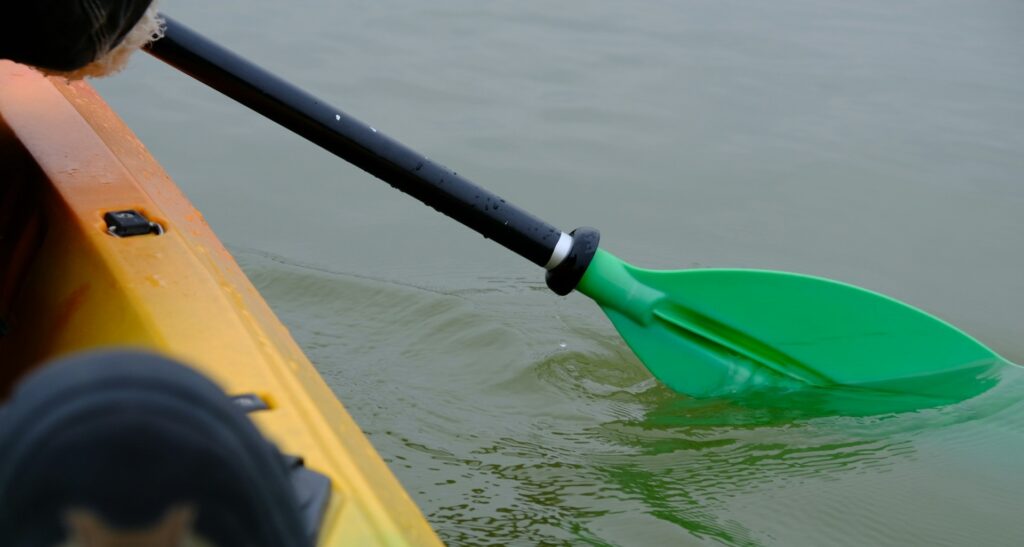So you’re staring at a wall of paddles, thinking they all look the same but also not really. Long sticks with blades, right? Except some look skinny like broom handles, others broad like shovels, and then there’s the weird bent ones that look like they were made wrong but they’re not. The paddle thing gets confusing fast. People think the kayak itself is the star, but no, your paddle is literally the thing that makes you move. Mess it up and you’ll hate every second on the water.
Blade Shape Matters More Than You Think
Some blades are narrow, like a willow leaf, kind of stretched out. Others are wide, chunky, almost like the end of an oar. The first one is called a low-angle blade. They’re for chill paddling, touring, longer distances where you don’t want your shoulders screaming after ten minutes. With these, your paddle stays closer to the water, kind of flatter. The wide ones, high-angle blades, are for power strokes. Short bursts, quick maneuvering, whitewater kind of chaos. If you try using a fat blade on a 20-mile calm lake trip, you’ll regret life choices.
And here’s the thing nobody tells you: blade surface area actually affects calorie burn. A 2019 kayaking physiology study showed paddlers with wide blades burned 12 to 18% more calories per hour than those with narrow blades. That sounds great if you’re training, not so great if you just want to float around and eat sandwiches.
Shaft Length and Why Height Makes You Overthink
Paddle length charts exist. They say, “If your kayak is this wide, and you are this tall, then you need X centimeters.” Very official looking. But reality isn’t that tidy. A 220cm paddle might feel perfect in a 24-inch wide touring kayak but way too short if you move to a recreational tub that’s 30 inches wide.
Tall folks usually go longer paddles, shorter folks shorter. But that’s not the whole story. Your torso length matters more than your overall height. Someone 5’6” with long arms might need the same paddle as a 6’0” person with stubby arms. That’s why people on forums complain, “The chart lied.”
Pro racers? They obsess about centimeters. A single change of 5cm can tweak cadence, fatigue, even blister spots. For casual paddlers, you’ll probably just adjust by angling your strokes differently, but yeah… length matters more than you think.
Straight vs Bent Shaft: the Ergonomic Argument
Straight shafts are standard. Cheap, simple, easy to find. Bent shafts have kinks where your hands grip, supposedly putting your wrists at a more natural angle. Less stress, less numbness, especially on long trips. Some swear by them, others say they’re a gimmick. I tried one once, honestly, it felt weird at first, then halfway through the trip my hands felt less tingly than usual. Could’ve been placebo. Hard to tell.
Data backs it a bit though: kayaking ergonomics research from Scandinavia showed bent shafts reduced wrist deviation angles by 15%. That’s not trivial. If you’ve ever gotten tendonitis from paddling, you start caring about that. Downside is price. Bent shafts can be 1.5x to 2x more expensive. That leads into the eternal truth: the paddle you want is usually pricier than your kayak rental.
Feathered vs Unfeathered Blades
Here’s where new kayakers look at you like you’re speaking Martian. Feathered paddles mean the blades aren’t aligned. One is twisted a bit compared to the other, usually 30 to 60 degrees. Why? When one blade is in the water, the other slices the air more cleanly, less wind resistance. Makes a difference on gusty lakes.
Old-school paddlers learned with feathered blades and stick to it religiously. Newbies often find it confusing because you have to rotate your wrists more. Some paddles have adjustable ferrules now, so you can pick feather angle or go unfeathered. Honestly, unless you’re racing or dealing with strong winds, you probably won’t notice much. But once you train muscle memory one way, switching feels like trying to write left-handed.
Materials: Weight is Everything
Aluminum shafts with plastic blades are cheapest. Heavy though. You won’t notice weight in the store, but after 10,000 strokes (which is like a single decent lake day), you’ll notice. Fiberglass is lighter, stronger, mid-range in price. Carbon fiber? Dreamy. Stiff, feather-light, but can cost more than your kayak itself.
For context, average kayak paddle weights:
- Aluminum/Plastic: 35–42 oz
- Fiberglass: 28–34 oz
- Carbon Fiber: 20–28 oz
That 10–15 ounce difference doesn’t sound like much. But multiply it by thousands of strokes and your shoulders will thank you later.
Whitewater vs Touring vs Fishing Paddles
Different paddling styles really need different tools. Whitewater paddlers want short, tough paddles. Wide blades for quick reaction in rapids. Touring paddlers want long, efficient ones, usually low-angle. Fishing paddles often have little features like measurement marks on the shaft, or hook retrieval cutouts on the blade. That’s not a gimmick; pulling a snagged lure without tipping over is a real problem.
And then there are greenland paddles, long skinny wooden sticks traditional to Inuit kayakers. Minimalist, but surprisingly efficient. Studies comparing them to modern paddles show slightly slower top speed but lower long-term fatigue. Some sea kayakers swear by them because the stroke feels smoother, easier on joints.
So Which One Is Best?
That’s like asking which shoes are best: depends if you’re sprinting, hiking, or just walking your dog. If you’re casual, rent-a-kayak-once-a-summer type, then aluminum is fine. If you paddle weekly, invest in fiberglass. If you’re obsessive or racing, carbon is worth it. Low-angle blades for calm distance. High-angle for aggressive control. Bent shaft if your wrists complain. Feathered if the wind fights you, unfeathered if you like simplicity.
In the end, your body will tell you. If your shoulders ache too fast, it’s too heavy. If your wrists hurt, maybe wrong angle. If you feel like you’re splashing more than gliding, blade shape mismatch. People get so caught up in brand names, but fit and feel matter way more.
And here’s a side comment: spend as much as you can justify on the paddle, not just the kayak. Because a $200 kayak with a $300 paddle is usually a better experience than a $1000 kayak with a $40 paddle. That’s the dirty secret most shops won’t tell you upfront.

